History
The work was commissioned in 1939 by the Ministry of Popular Culture to the sculptor Arturo Dazzi from Carrara to decorate Piazza Imperiale – which, according to the project of the 1942 World's fair of Rome, should have been located in the center of the newborn quarter – and to commemorate the physicist and inventor Guglielmo Marconi (who had died 2 years earlier).
With the entry of Italy into the World War II in 1940, the works were suddenly interrupted, even if Dazzi had already completed the first two registers, carved in high relief on Carrara marble. In 1951 work resumed, despite the intention of the Ministry of Public Works, chaired by Salvatore Aldisio, to demolish the structure.
In 1953, on the occasion of an Agricultural Exhibition held in EUR, the sculptor refused to cover the reinforced concrete structure with temporary panels of gesso and, after having requested some funding in view of the 1960 Summer Olympics, the monument was concluded and inaugurated on 12 December 1959. [1]
Description
The structure of the obelisk has the shape of a truncated pyramid and is made up of reinforced concrete covered with 92 slabs of Carrara marble, on which the high reliefs, arranged in 4 rows, are carved. [2]
The obelisk is placed in the center of the square, today named after Guglielmo Marconi; in the green flowerbed that surrounds it, the sculpture The awakening, a work by Seward Johnson, was placed in 2009 and removed in 2011. [3]

Guglielmo Giovanni Maria Marconi, 1st Marquis of Marconi was an Italian inventor and electrical engineer, known for his creation of a practical radio wave–based wireless telegraph system. This led to Marconi being credited as the inventor of radio, and he shared the 1909 Nobel Prize in Physics with Karl Ferdinand Braun "in recognition of their contributions to the development of wireless telegraphy".

Carrara is a town and comune in Tuscany, in central Italy, of the province of Massa and Carrara, and notable for the white or blue-grey marble quarried there. It is on the Carrione River, some 100 kilometres (62 mi) west-northwest of Florence. Its motto is Fortitudo mea in rota.

Alexander Stepanovich Popov was a Russian physicist who was one of the first people to invent a radio receiving device.

Piazza del Popolo is a large urban square in Rome. The name in modern Italian literally means "People's Square", but historically it derives from the poplars after which the church of Santa Maria del Popolo, in the northeast corner of the piazza, takes its name.

Filippo Barigioni (1690–1753) was an Italian sculptor and architect working in the Late Baroque tradition.
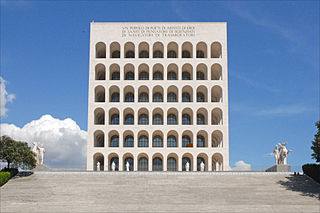
The Palazzo della Civiltà Italiana, also known as the Palazzo della Civiltà del Lavoro, or in everyday speech as the Colosseo Quadrato, is a building in the EUR district in Rome. It was designed in 1938 by three Italian architects: Giovanni Guerrini, Ernesto La Padula, and Mario Romano. The building is an example of Italian Rationalism and fascist architecture with neoclassical design, representing romanità, a philosophy which encompasses the past, present, and future all in one. The enormity of the structure is meant to reflect the fascist regime's new course in Italian history. The design of the building draws inspiration from the Colosseum with rows of arches. According to legend, the structure's six vertical and nine horizontal arches are correlated to the number of letters in the Italian dictator Benito Mussolini's name.
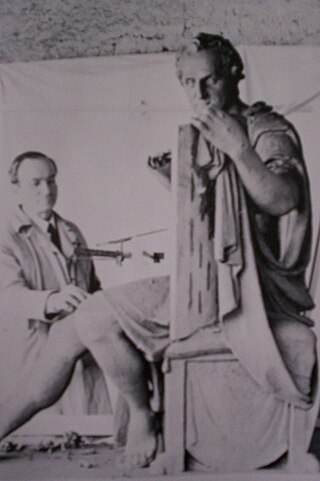
Romano Vio was an Italian sculptor. He was born in Venice and taught sculpture there.
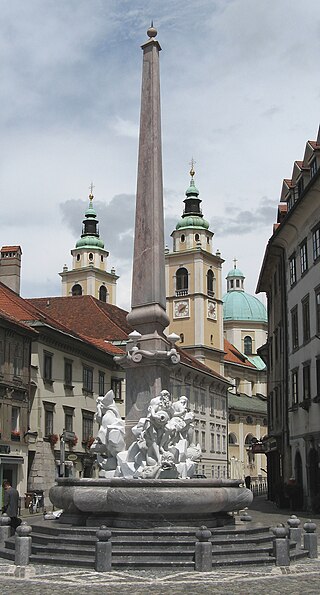
The Robba Fountain, since the first half of the 20th century also known as the Fountain of the Three Carniolan Rivers, is the fountain that stands in front of Ljubljana Town Hall at Town Square in Ljubljana, the capital of Slovenia. It was originally made in 1751 by the Italian sculptor Francesco Robba and is one of the city's most recognisable symbols.

The Piazza della Rotonda is a piazza in Rome, Italy, on the south side of which is located the Pantheon. The square gets its name from the Pantheon's informal title as the church of Santa Maria Rotonda.
The architecture of Rome over the centuries has greatly developed from Ancient Roman architecture to Italian modern and contemporary architecture. Rome was once the world's main epicentres of Classical architecture, developing new forms such as the arch, the dome and the vault. The Romanesque style in the 11th, 12th and 13th centuries was also widely used in Roman architecture, and later the city became one of the main centres of Renaissance and Baroque architecture. Rome's cityscape is also widely Neoclassical and Fascist in style.

Arturo Dazzi was an Italian painter and sculptor.

The Flaminio Obelisk is one of the thirteen ancient obelisks in Rome, Italy. It is located in the Flaminio quarter on Piazza del Popolo.
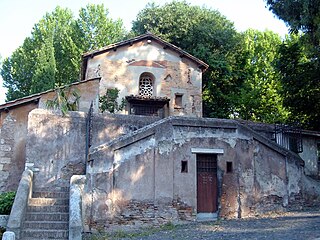
Portuense is the 11th quartiere of Rome (Italy), identified by the initials Q.XI.
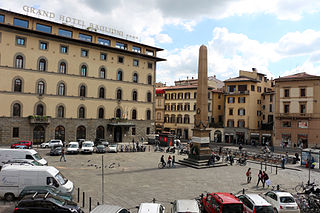
The Obelisk of the Fallen in the Wars of Independence in the Piazza dell'Unità Italiana, once called the Piazza Vecchia di Santa Maria Novella, is a monument located in the piazza just east of the apse of Santa Maria Novella, surrounded by large hotels and offices located near the main train station in Florence, Italy.

The Boboli obelisk, previously called the Obelisco Mediceo, is an ancient Egyptian granite obelisk, which was moved in the 18th century from Rome to Florence, where it was erected in the Boboli Gardens.

The Arco della Vittoria, also known as Monumento ai Caduti or Arco dei Caduti, is a memorial arch located in Piazza della Vittoria in Genoa, Italy. It is dedicated to the Genoese who died during World War I, and it was inaugurated on 31 May 1931.
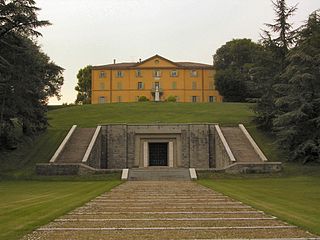
The Museum and Mausoleum of Guglielmo Marconi is a museum and burial structure for the Italian scientist, inventor, and engineer, Guglielmo Marconi. The tomb is located adjacent to the 17th-century Villa Griffone/Villa Marconi, located on via Celestini #1 in Pontecchio Marconi, about 15 kilometers outside the city of Bologna in Emilia Romagna, Italy.
Antonio Berti was an Italian sculptor and medalist. He taught at the Accademia di San Luca and the Accademia di Belle Arti in Florence.
This page is based on this
Wikipedia article Text is available under the
CC BY-SA 4.0 license; additional terms may apply.
Images, videos and audio are available under their respective licenses.

















